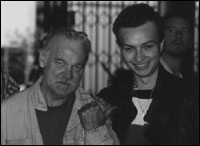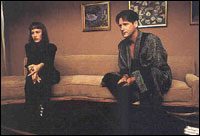 |
|
|
|
Objectif
Cinema : Did you also talk
with the actors ?
Roland Kermarec : I was
a bit shyer with the actors. I never really talked with Patricia
Arquette, who kept her distance anyway, even if she did seem
rather nice and plain. Bill Pullman, however, came to see
me rather often, and he had a little running joke about a
stool that I would sit on all the time to write, a stool on
which he expected to see me on all day long.
Later on, I would have long discussions with Jack Nance. He
came for a few days on the set to play a small part in "Arnie's
Garage", where the character played by Balthazar Getty worked.
After all, he was Lynch's favorite actor and he had played
in all his movies except The Elephant Man ! It
made for some of the most emotional moments on the set. At
first, it was I that went to him for an interview, but, after
a while, he would come to me and we would go into his dressing
room during make-up. In an hour, I could ask him only about
two or three questions, he wouldn't stop talking, telling
anecdotes, sometimes funny, sometimes tragic. I learned of
his death little after the end of the production. He had been
mugged in the street over a rather sordid story.
Objectif Cinema : When
did the shooting of "Lost Highway" exactly take place ?
Roland Kermarec : It started
in the last days of November 1995 and finished in the first
days of March 1996.
Objectif Cinema : So
you stayed on the set for the whole production ?
Roland Kermarec : Yes.
Except for the scenes with Marilyn Manson and the two girls
(the "porno shoot" as Lynch called it) that were shot before
my arrival. I don't think I could have been there anyway !
| |
 |
|
|
Objectif
Cinema : What surprised you
the most about Mr. Lynch's more direct and practical directing ?
Roland Kermarec : There
were some euphoric moments in the dream sequence that takes
place in the Madison house. At first, we only saw Fred Madison
(Bill Pullman) walk in the living room. As was written in
the script. They set up the dolly shot to follow the character.
Then David started changing the scene by the minute. I saw
ideas just pop out of his head like little light bulbs...
He first added the smoke that came up the stairs, then shot
it all in slow motion, always playing Rammstein's music full
blast on the set, which added a surprising atmosphere and
gave the crew a boost of energy.
There were three paintings, by Lynch's first wife, hung on
the wall over the couch. They were not in the script, but
it was on Thanksgiving evening that he rediscovered them and
decided to use them. One of the paintings especially is actually
very close to the story's intrigue : it shows the body
of a woman sliced into small parts... For this dream sequence
he went to the paintings, stared at them for a long while,
and hung them upside down ! To the amazement of the Director
of photography.
But for Lynch it didn't seem quite right yet : there
was no fire in the fireplace ! He ran home, got some
matches and lit the fire himself... full of an amazing energy !
He had a very strong adrenaline rush, like a kid that had
just discovered a new game. In the finished scene, we see
Fred walking in the smoke past the upside down paintings,
with a close-up of the fireplace filmed in high speed. And
this is how a simple line from a script becomes what he had
always said; that the script is only a base, you have to stay
open to new ideas that can actually come to you during the
shooting. I saw these ideas just come to him one after the
other, it's really amazing, a moment of general enthusiasm !
I had the impression of seeing his brain work at full capacity
and was a witness to one of his creations, which I love so
much. It was a rare privilege.
|